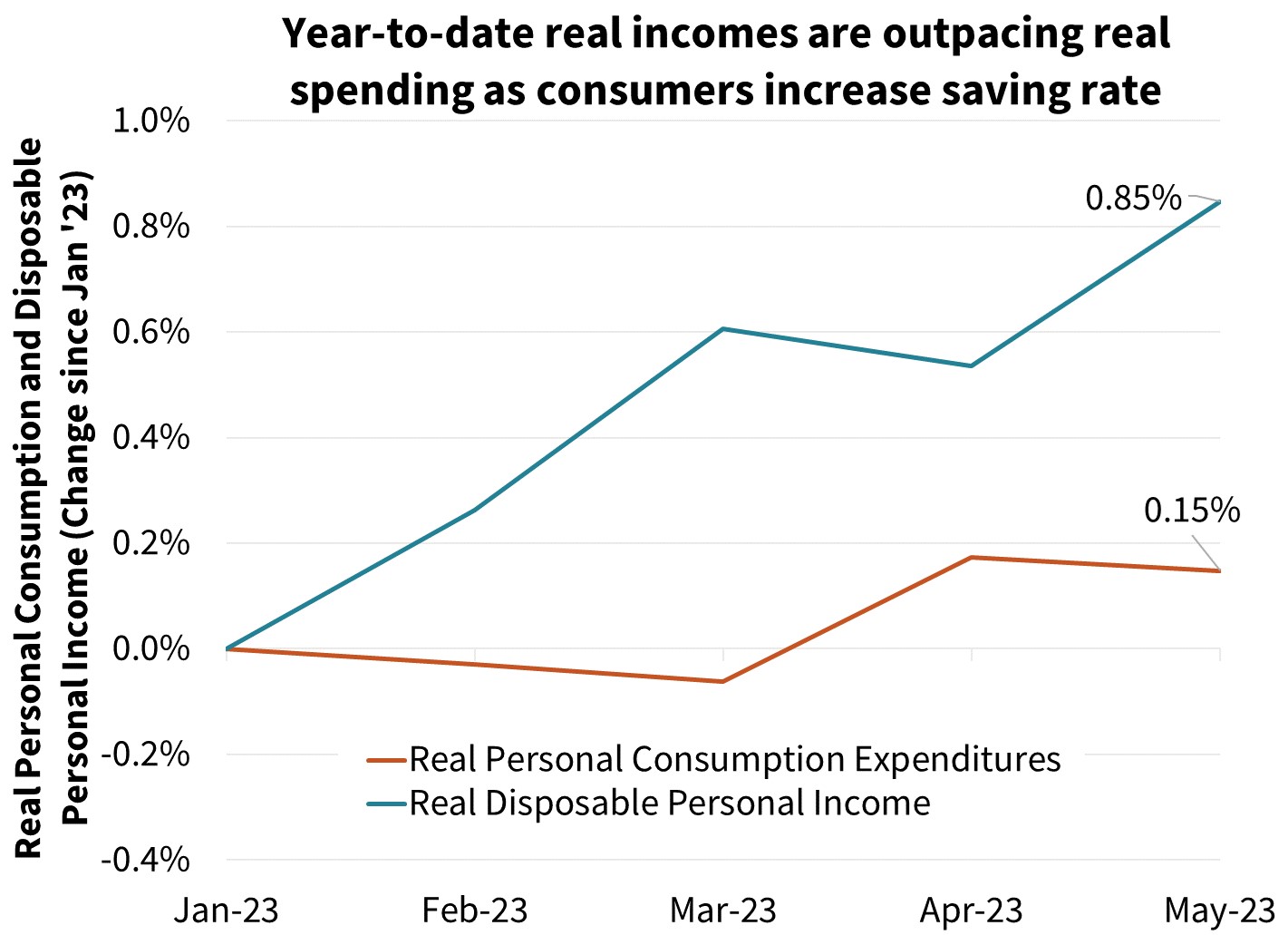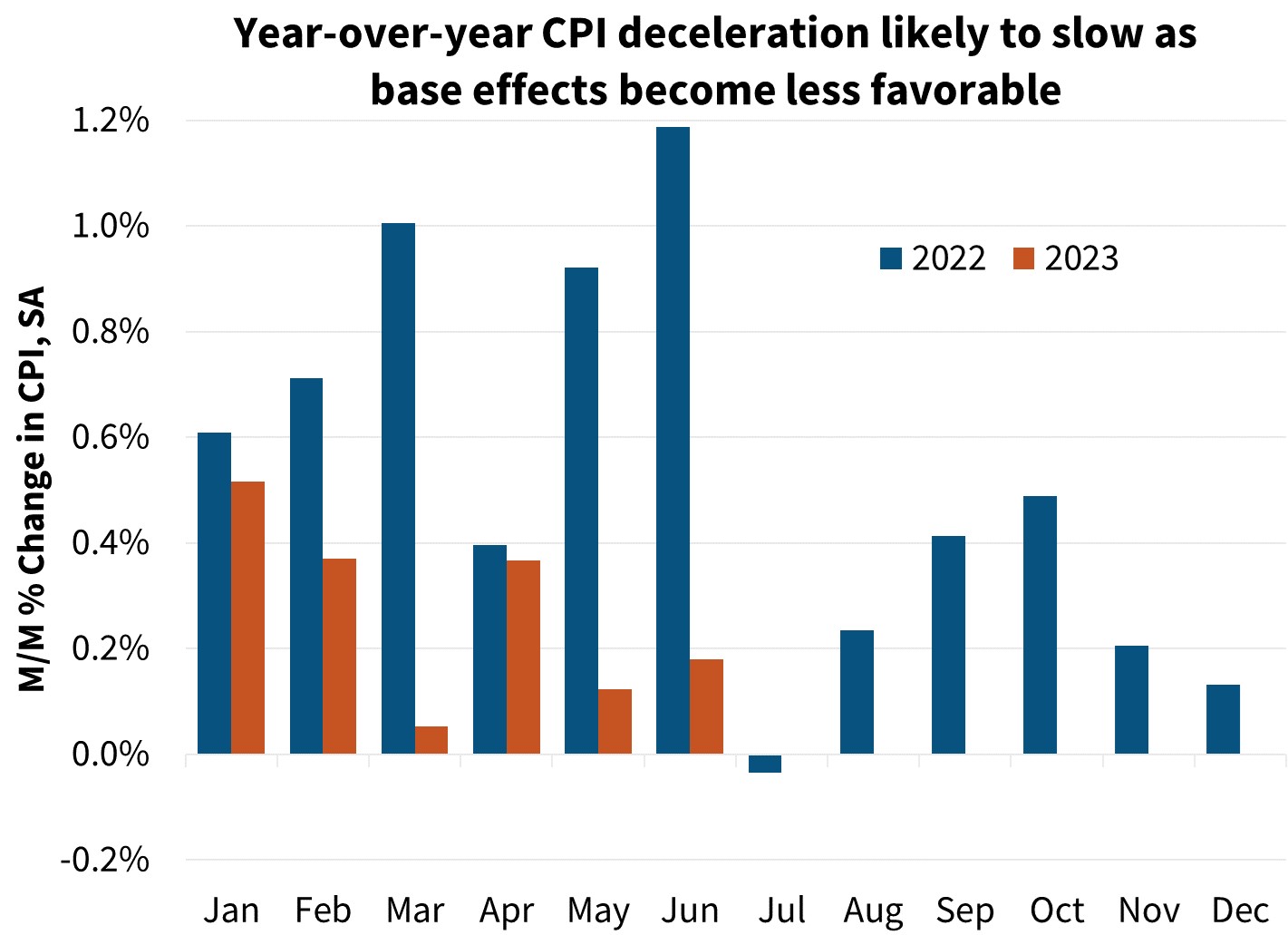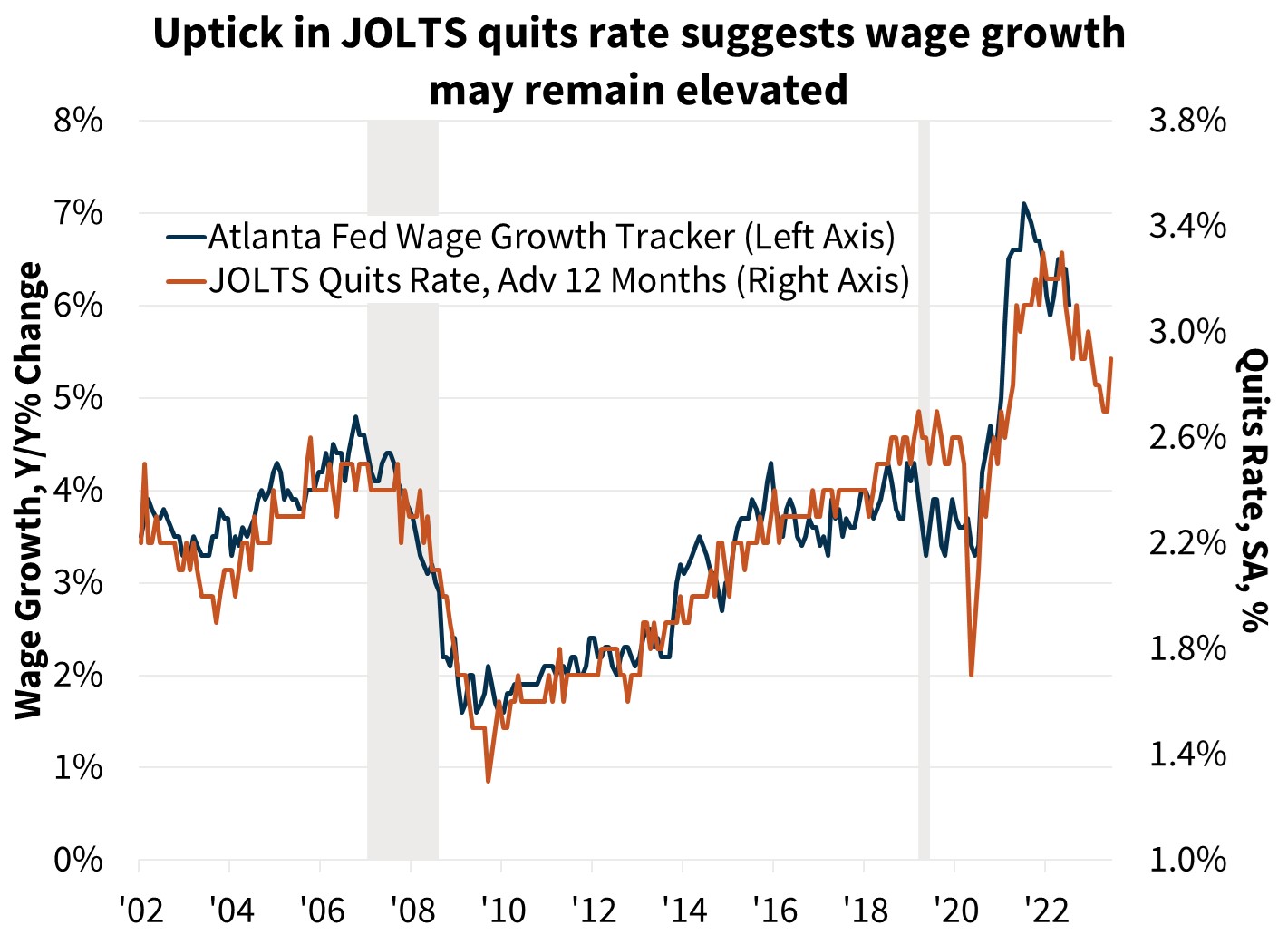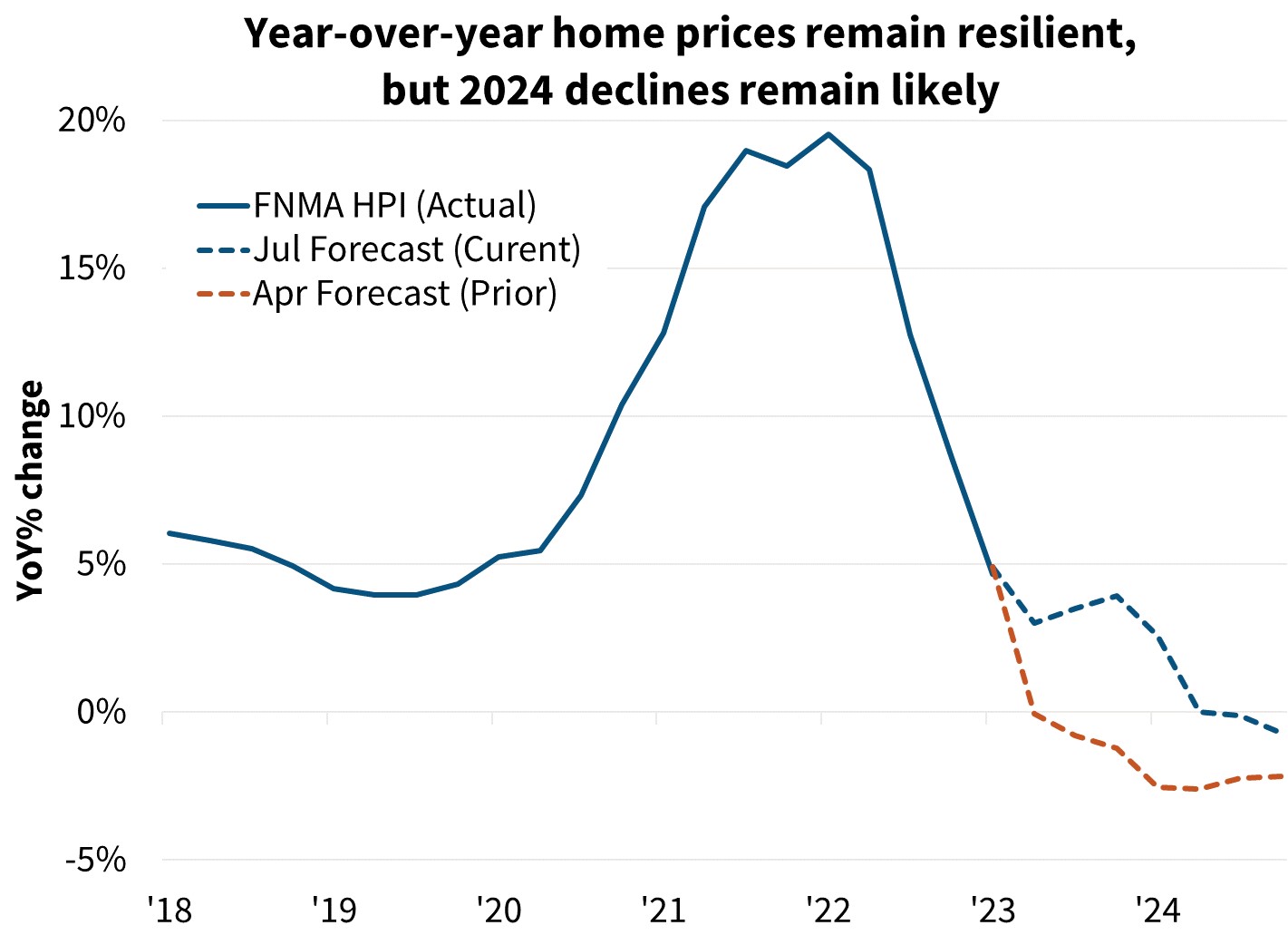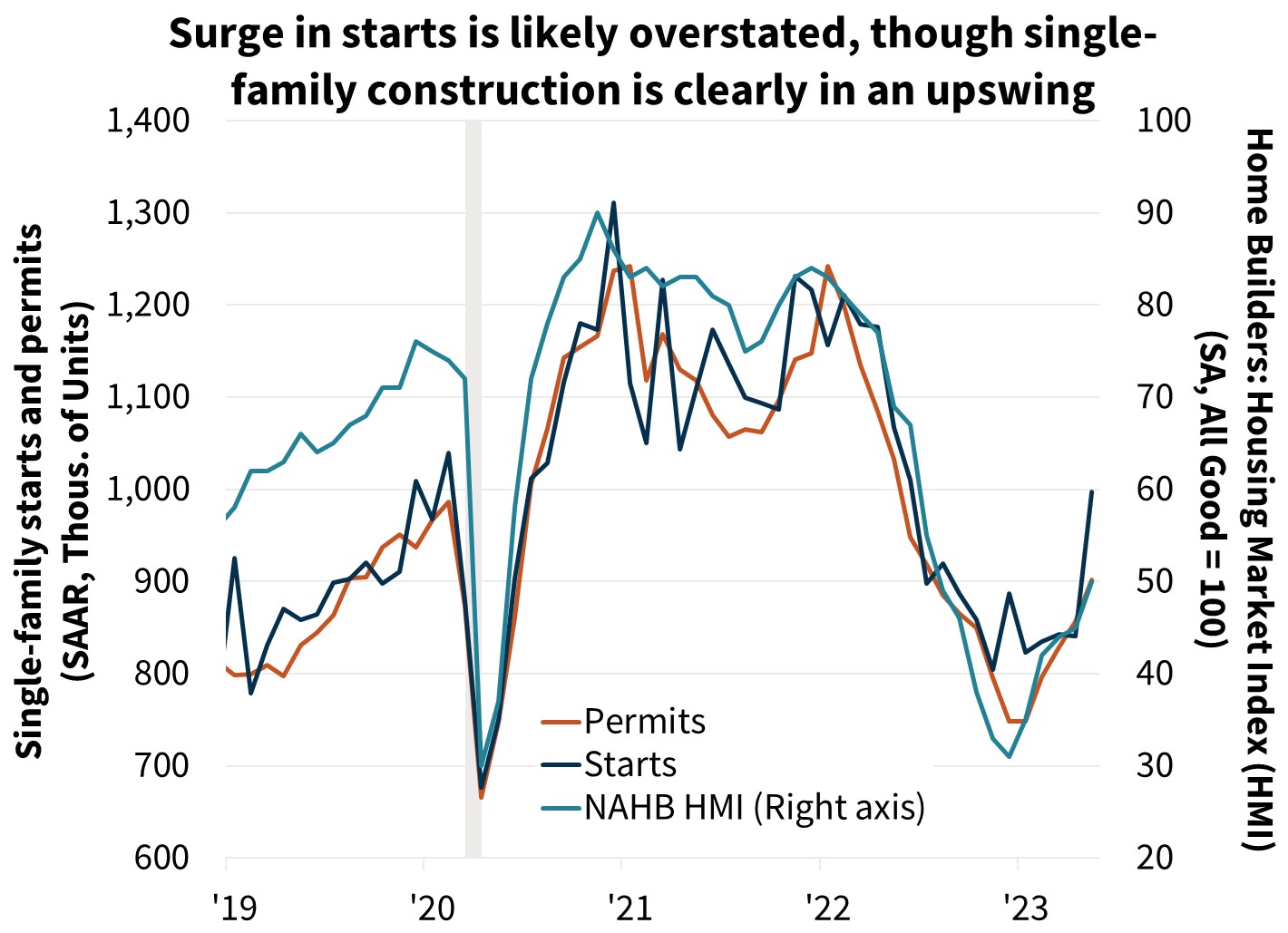Recent Annual Declines in Inflation Likely to Moderate, While Economic Growth Slows Over Second Half
Inflation continues to swiftly decelerate on an annual basis, with the Consumer Price Index (CPI) falling to 3.0 percent in June, down from 4.0 percent in May. The core index came in at 4.8 percent, down from 5.3 percent in May. While we anticipate modest month-over-month topline inflation over the second half, the pace of future annual reductions is likely to level off over the next six months due to less favorable year-ago comparisons going forward. We forecast the headline and core Consumer Price Index (CPI) rates to be around 3.1 percent and 4.3 percent, respectively, in the fourth quarter. Substantial revisions to first quarter data alongside ongoing resilience in the labor market and new home construction now point to the first half of 2023 having experienced a stronger pace of economic growth than we had previously expected. Conceptually, our macroeconomic forecast is little changed from last month, including a call for a modest recession beginning in the fourth quarter of this year or the first quarter of next year. However, we have upgraded our 2023 real gross domestic product (GDP) growth outlook to 1.1 percent from 0.1 percent on a Q4/Q4 basis, largely reflecting a stronger than previously anticipated first half of this year.
With an ongoing tight supply of existing homes for sale on the market, we expect overall home sales in 2023 to remain near the lowest annual level since 2009. This lack of supply is driving a resurgence of home price growth and supporting increases in new home construction. As such, we have upwardly revised both our home price and single-family housing starts outlook. As measured by the Fannie Mae Home Price Index (FNM-HPI), we forecast 2023 and 2024 home price growth will be positive 3.9 percent and negative 0.7 percent on a Q4/Q4 basis, respectively, up from negative 1.2 percent and negative 2.2 percent in our prior quarterly update. We have upgraded our single-family housing starts forecast to 896,000 units for 2023 and to 890,000 units for 2024, up from 824,000 and 845,000, respectively. The combination of an upward revision to the home price outlook and greater expected home construction has also led to a slight upgrade in our forecast of 2023 mortgage originations. Our 2024 mortgage originations forecast is unchanged as the effects of our previously mentioned revisions to our home price outlook and a lower existing sales outlook largely offset each other. We anticipate total single-family originations will be $1.62 trillion in 2023, up from last month’s prediction of $1.59 trillion, while we maintained our forecast for 2024 single-family originations at $1.9 trillion.
First Half of the Year Stronger Than Previously Thought, But Likely Slowing Ahead
The Bureau of Economic Analysis’s third estimate of first quarter GDP contained an unusually large upward revision of seven-tenths from the prior release (and nine-tenths above the initial release), bringing the annualized growth rate to a healthy 2.0 percent. As such, we have upgraded our 2023 growth outlook by a full percentage point, reflecting the now stronger than previously thought start to the year and some additional flow-through of economic momentum resulting from that stronger start to the year. However, we expect growth to decelerate as the year further unfolds. We believe the current pace of consumer spending remains unsustainable given income levels and, to date, has been supported by drawing down pandemic-related savings and taking on additional debt. This has resulted in a low personal savings rate, most recently measured at 4.6 percent, in contrast to the pre-pandemic norm of around 7.5 percent. From January to May, real personal consumption expenditures are up a meager 0.15 percent, despite real disposable personal income rising by 0.85 percent over the period, suggesting that households are in the process of returning to a more typical relationship between spending and income. The likely resumption of student loan payments this fall presents an additional headwind for consumer spending.
Additionally, in our view, the full effects of tightening monetary policy on economic activity are still to be felt. Monetary policy works with notoriously long and variable lags (a rule of thumb is it takes 12-18 months for effects to be fully realized), and the policy rate has not been in an obviously restrictive territory for long. The theoretical neutral level for the federal funds rate, at which policy is neither stimulative nor restrictive, is widely estimated to be around 2.5 percent. The federal funds rate only exceeded 2.5 percent in September 2022. Arguably, given recent inflation levels well above the 2 percent target, the real short-term interest rate is more indicative of the monetary policy stance. The federal funds rate did not exceed the year-over-year personal consumption expenditures (PCE) inflation rate until this past March. It should be noted that bank lending, one of the key mechanisms through which monetary policy affects the real economy, only started slowing this past spring. Other measures of the credit cycle, specifically consumer credit delinquency rates and business bankruptcy filings, are now also turning upward. This, combined with the aforementioned consumer spending/income dynamic, leads us to continue to anticipate slowing activity later this year.
Inflation Decelerating Sharply but Further Annual Improvement Will Be More Difficult
With the topline CPI falling to 3.0 percent on an annual basis in June, it has decelerated sharply since the start of the year, when the CPI was at 6.4 percent. The core index, while not slowing as quickly, is also down meaningfully over the last 6 months, sitting at 4.8 percent in June, compared to 5.6 percent at the start of the year. The annual deceleration thus far is encouraging; however, moving forward, further declines toward the Fed’s 2-percent target on an annual basis will likely take longer as June was the last of the very favorable prior year comparisons. Headline CPI inflation must loosely average no more than 0.2 percent on a month-over-month basis for the remainder of the year in order for the annual rate to end lower than the most recent reading.
Optimistically, there are a number of near-term factors pointing to this occurring. Market measures of used car prices suggest that this component will start dragging strongly on the CPI in the coming months, and shelter inflation, which has driven much of the index over the past year, is now beginning to decelerate. It is expected to continue to do so based on the lagged relationship from market asking rents measures that have already been subdued. Additionally, the Producer Price Index (PPI) was up only 0.1 percent on an annual basis in June, business surveys continue to show moderating prices paid by firms, and negative year-over-year price changes to imports all point to further downward pressure on the goods-related portion of the CPI in coming months. Therefore, assuming relatively stable energy prices, our outlook for the remainder of the year is for a continuing modest deceleration in annual core inflation while the headline remains roughly in line with the most recent June reading.
However, our anticipation of subdued month-over-month inflation reports in the coming months may mask underlying core inflationary pressure. As the Federal Reserve has often commented on, the underlying tightness in the labor market is not consistent with inflation ultimately settling at a 2-percent target. Therefore, despite improvement in recent inflation measures, we expect Fed policy to remain tight until it is clear that the labor market has softened sufficiently.
Currently, labor market indicators are painting too mixed of a picture to conclude that sufficient softening has occurred. Nonfarm payroll employment increased by 209,000 in June, while the April and May reports were revised downward by a combined 110,000 jobs. That put employment growth a touch below our expectations and represents the first time that consensus estimates were above the actual payroll growth figure since March 2022. Combined with a jump of 452,000 people employed part time for economic reasons, a declining trend in the average workweek since the beginning of 2021, and small net job losses in a number of industries, including the typically leading temporary employment sector, we think there are signs of cracks in the labor market.
Still, other data suggest the labor market remains unusually tight. After averaging 0.3 percent month-over-month gains from January to March, average hourly earnings are now averaging 0.4 percent gains over the past three months, which translates into an annual pace of around 5 percent. The Atlanta Fed Wage Tracker, which controls for job compositions, is also indicating annual wage gains of 5.3 percent, a heightened pace. Combined with an increase in the May quits rate in the Job Openings and Labor Turnover Survey (JOLTS), which is also correlated with wage growth, the current labor market likely remains too tight to be consistent with the Fed’s 2-percent inflation target. Given current productivity levels, we estimate current wage growth trends suggest an underlying core inflation trend in the 3-4 percent range.
Given the Fed’s stated desire to cool labor market conditions, we believe the Fed will interpret the incoming labor market data as still too hot and will continue a higher-for-longer monetary policy stance, including a rate hike at its next meeting. We believe this stance is likely to persist until the labor market has clearly cooled, a standard that has not yet been achieved given ongoing wage pressures. One of the lessons of the 1970s-80s inflationary period was that a premature end to tightening can easily lead to a reacceleration in inflation.
Upgrades to Home Price and Construction Outlook as Existing Homes Available Remain Scarce
Looking back over the first half of 2023, existing home sales have been largely in line with our forecasts, oscillating on a monthly basis in the range of 4-4.5 million annualized units. If this rate of growth is maintained for the remainder of the year, 2023 will be the slowest pace of existing sales since 2011. However, unlike 2011, the subdued rate of sales has not been driven by a lack of purchase demand but rather an historically tight inventory of homes for sale.
The extent of the ongoing lack of inventory has exceeded our prior expectations. After improving for much of 2022, according to Redfin, at the beginning of July, active listings of homes for sale were down 14.4 percent from a year prior. This ongoing lack of inventory, in part due to mortgage lock-in effects, has driven significantly stronger home price appreciation over the first half of 2023 than we had previously anticipated. According to the Fannie Mae HPI, while the annual pace of home price growth decelerated in Q2 to 3.0 percent (down from 4.9 percent in Q1), this was entirely driven by base effects. On a quarterly basis, seasonally adjusted home price growth accelerated to 1.9 percent in Q2 (3.6% on a non-seasonally adjusted basis), up from 1.3 percent in Q1 (1.4% on a non-seasonally adjusted basis) and the modest declines seen in the back half of 2022. Q2's pace of growth on an annualized basis was almost 8 percent, a strong pace of appreciation well above both the current growth rate of household incomes as well as the historical average. A consequence of this strong home price growth is that affordability again worsened. We still anticipate a slowing of home price growth going forward as economic activity slows, more new constructed units hit the market, and affordability challenges weigh on demand; however, improvements in affordability now appear further off than they did at the start of the year.
The resurgence in home price growth, driven by a lack of existing homes for sale, has been highly supportive of new construction. Single-family housing starts surged 18.5 percent in May to a pace of 997,000 units, the highest level in a year and well above expectations. While we are discounting some of this jump as statistical noise in part because the less volatile permits figure came in considerably lower, there is no doubt that both permits and starts are on the upswing. New home sales also jumped in May, rising 12.2 percent. Continued improvement in homebuilder sentiment surveys, as well as comments and guidance from the major publicly traded builders, are also supportive of this recent improvement. Additionally, homebuilders continue to use rate buydowns to help drive sales, and with many construction input prices, including that of lumber, being lower than a year ago, builders continue to have ample margin to offer incentives. We have therefore significantly upgraded our housing starts outlook. It should also be noted that our construction outlook is predicated on a modest economic contraction beginning in the fourth quarter of this year or first quarter of next year. If a recession is avoided over the coming quarters, there remains ample demand for a stronger pace of housing starts than what is reflected by our baseline forecast. Based on the recent pace of housing completions, we believe the home-building industry is capable of a starts pace of around one million annualized single-family units for a sustained period. That is to say that there is significant upside risk to our starts outlook if the macroeconomy is supportive.
Multifamily starts jumped 27.1 percent in May, but this series is even noisier than single-family starts. Based on private sector estimates of multifamily construction pipelines, as well as what appears to be increasing reluctance on the part of many banks to aggressively increase multifamily construction lending, we anticipate the multifamily starts number to pull back considerably in the coming months (with possible large revisions to current data as well). As a backdrop, while strained affordability measures on single-family housing will likely keep some renting households occupying multifamily units for longer, there is also a record number of multifamily units (nearly 1 million) currently under construction that will come online over the next year or so. Vacancy rates have risen toward a more normal pre-pandemic level and rent growth is expected to be modest. Therefore, we expect a meaningful pullback in multifamily starts, especially if bank lending conditions continue to tighten.
Purchase Mortgage Originations Upgraded on Stronger Home Prices
We have upgraded our forecast for single-family purchase mortgage originations, driven primarily by our more optimistic home price expectation, and to a lesser extent an upwardly revised forecast for new home construction. In particular, we now expect purchase originations to be $1.35 trillion in 2023 and $1.44 trillion in 2024, representing upward revisions of $34 billion in 2023 and $29 billion in 2024.
For refinance originations, we have revised downward our projected 2023 and 2024 volumes by $6 billion and $28 billion to $264 billion and $465 billion, respectively. The downward revision can be attributed to continued limited refinance application activity measured by our Refinance Application-Level Index (RALI) and a modest upward revision to our interest rate forecast. On the other hand, our stronger home price expectation compared to the last forecast limits some of the expected downward pressure from rates and application volumes. This offsetting dynamic resulted in a relatively small change in our forecast for total refi origination volumes.
Economic & Strategic Research (ESR) Group
July 13, 2023
For a snapshot of macroeconomic and housing data between the monthly forecasts, please read ESR’s Economic and Housing Weekly Notes.
Data sources for charts: Bureau of Economic Analysis, Bureau of Labor Statistics, Fannie Mae, National Association of Homebuilders, Census Bureau.
Opinions, analyses, estimates, forecasts and other views of Fannie Mae's Economic & Strategic Research (ESR) Group included in these materials should not be construed as indicating Fannie Mae's business prospects or expected results, are based on a number of assumptions, and are subject to change without notice. How this information affects Fannie Mae will depend on many factors. Although the ESR group bases its opinions, analyses, estimates, forecasts and other views on information it considers reliable, it does not guarantee that the information provided in these materials is accurate, current or suitable for any particular purpose. Changes in the assumptions or the information underlying these views could produce materially different results. The analyses, opinions, estimates, forecasts and other views published by the ESR group represent the views of that group as of the date indicated and do not necessarily represent the views of Fannie Mae or its management.
ESR Macroeconomic Forecast Team
- Doug Duncan, SVP and Chief Economist
- Mark Palim, VP and Deputy Chief Economist
- Eric Brescia, Economics Manager
- Nick Embrey, Economist
- Nathaniel Drake, Economic Analyst
- Richard Goyette, Economic Analyst
